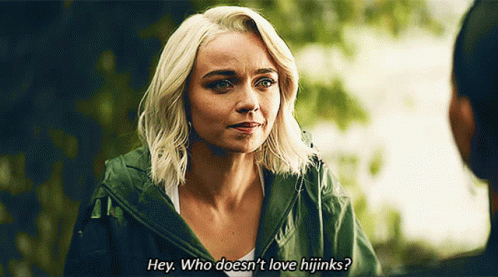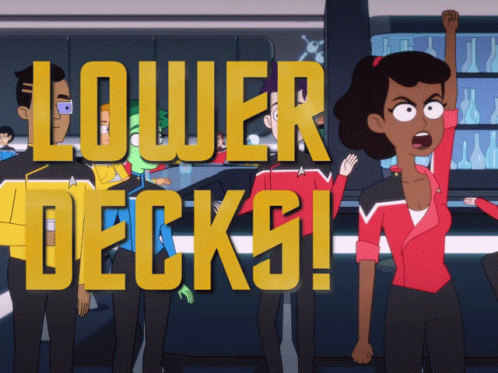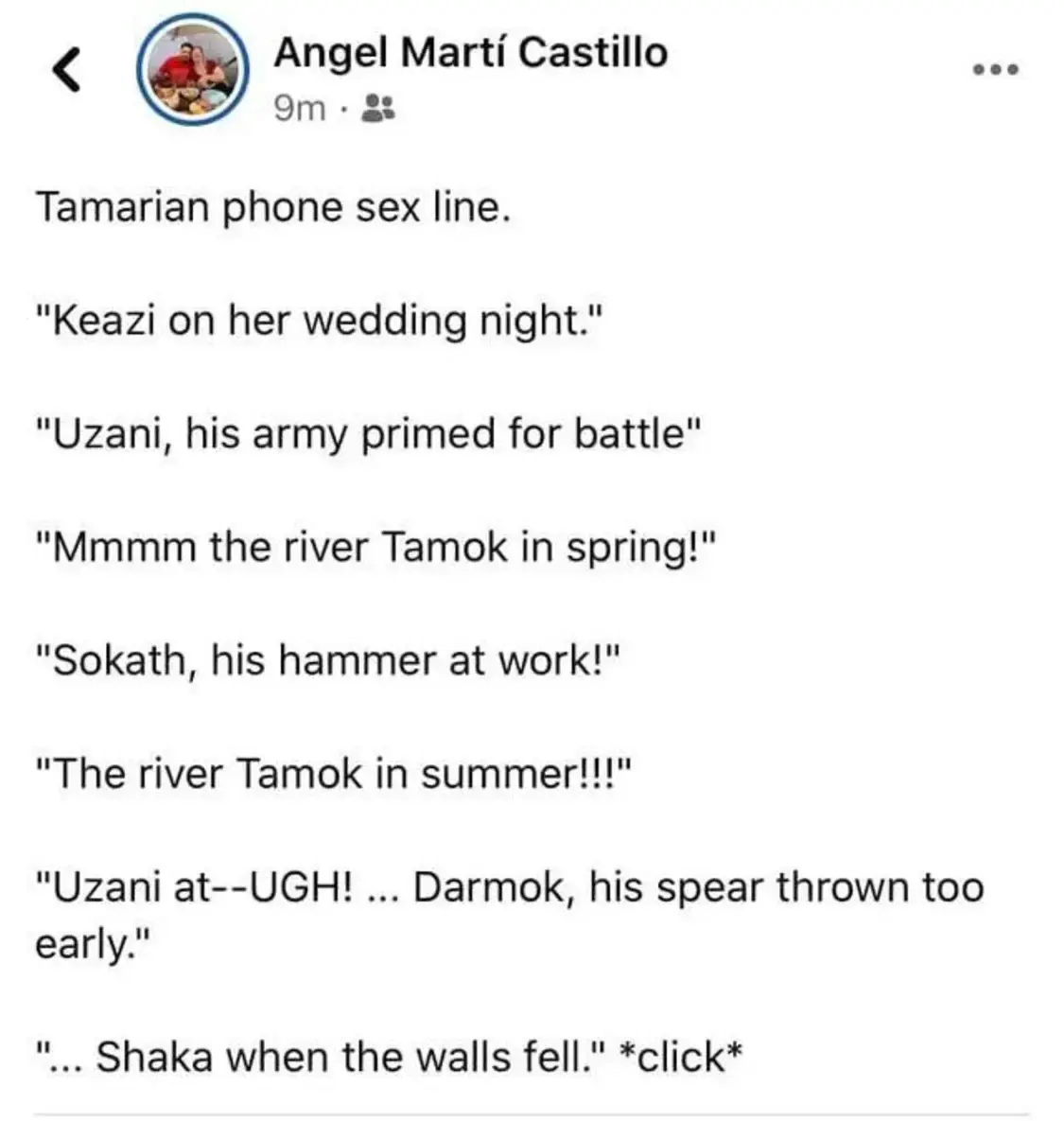This is the premiere of the fifth and final season of “Star Trek Discovery”, the first iteration of Trek’s modern era. I think it is important in this moment to acknowledge that, regardless of individual opinions of quality the series -- personally I am a fan, but this is not about my personal perspective -- without DIS we would not have the abundance of new Trek available to us.
With that acknowledgement aside, on with the very serious business.
• This episode is the first mention of the titular Red Directive. Starfleet has a number of directives most recognizable of which is the Prime Directive, introduced in “Return of the Archons”, which codifies interactions with non Federation cultures, and their principles of non-interference. There is also:
• The Temporal Prime Directive forbidding interference with historical events, first mentioned in “Future’s End, Part II”
• The Omega Directive, dictating the necessity of destroying any and all omega particles that might be encountered during the course of Starfleet activities, introduced in “The Omega Directive”
• This episode was written by DIS co-showrunner, Michelle Paradise, and directed by executive producer, Olatunde Osunsanmi.
• The episode opens with Captain Burnham [Sonequa Martin-Green] on the exterior of a ship at warp. We’ve previously seen characters outside ships traveling faster than light in “Divergence” and “Mindwalk”.
• The crew of the USS Discovery A attends a Millennium Celebration commemorating 1,000 years of the Federation. The Federation was founded in 2161, as per “These Are the Voyages…” and this episode takes place, presumably, in 2191. The cadet serving the signature cocktail, Tonic 2161, does comment ”Give or take a few decades,” when Tilly [Mary Wiseman] explains to Adira [Blu del Barrio] the context for the drink.
• Tonic 2161 is blue with stars floating in it to match the emblem of the Federation emblem.
• Ross claims the stars taste like jumja sticks, a Bajoran treat first seen in “A Man Alone”. Bajor has, to the best of our knowledge, not been inducted into the Federation at any point.
• Stamets [Anthony Rapp] is upset because Starfleet is “shuttering the spore drive program.” In season four, the program’s lead scientist used a stolen prototype to attempt to reach Species 10-C and kill them with an illegal weapon.
• A prototype pathway drive was mentioned as having been installed aboard the USS Voyager J in “Kobayashi Maru”.
• President T’Rina mentions the Tholian Republic and Breen Imperium as polities outside the current Federation, and seems to imply they’re antagonistic if not hostile to the Federation. The Tholian Assembly was introduced in the TOS episode “The Tholian Web”, and the Breen Confederacy was mentioned in “Strange Bedfellows”.
• The 800 year old Romulan science vessel is an update of the Romulan ship seen in “The Next Phase”.
• When L’ak removes his helmet, there is a brief moment where his face appears to be non opaque, not entirely dissimilar from how Changelings are see through in the natural state, or Mellanoid slime worms, such as Murf.
• L’ak is played by Elias Toufexis, who previously had a role DIS season one’s “Context is for Kings” as one of the other prisoners aboard the transport shuttle rescued by Discovery along with Burnham. He never asked for this.
• Antares is a well loved name for Starfleet vessels:
• Antares, NCC-501 - “Charlie X”
• USS Antares - A ship both Captain Pike and Number One served aboard, according to “Brother” and “Memento Mori” respectively
• USS Antares, NCC-9844, Miranda-class - “Favor the Bold”
• A Kelvin Universe USS Antares - 2009’s “Star Trek”
• In addition there are also three different Antares-class ships: one used by the Corvallens in “Face of the Enemy”; a carrier used by both Cardassians and Bajorans, introduced in “Ensign Ro”; a civilian freighter like Kasidy Yates’ SS Xhosa first seen in “Family Business”.
• There are new aspects integrated into the title sequence. For the purposes of this comparison I’ll be mentioning changes from specifically the season four sequence. Such as:
• A rotating planet with two moons has replaced the visualization of Zora’s program
• The captain’s chair appears earlier in the sequence
• A 3d representation of a symbol from a Romulan journal is shown
• The Infinity Room key appears, replacing an exploded planet, and Discovery approaching the DMA
• Book’s unnamed ship is replaced with Moll and L’ak’s
• A number of rotating structures are now at the very end where there used to be a long range view of the DMA
• Burnham, Owosekun, and Rhys find the mummified corpse of a Romulan wearing a TNG era uniform.
• We will learn that this Romulan was Doctor Vellek, a scientist present for the events of the TNG episode, “The Chase”.
• Burnham is able to grasp her phaser pistol, and stretch it out into a type-3 configuration. It’s unclear what advantage the transformation has. Other than Boimler’s assertion that, ”Uh, they take two hands,” from “Where Pleasant Fountains Lie”.
• Moll [Eve Harlow] and L’ak have a Romulan puzzle box, a tan zhekran, when Burnham confronts them. This puzzle box is larger than the one Narek had in “The Impossible Box”, and has more sides.
• When we see the Antares, it has the saucer of a Friendship-class starship, and the nacelles of Merian-class, both first seen in “People of Earth”.
• ”I would rather not die out here, I’ve got a saxophone lesson to get to.” Harry Kim took up playing the sax in “Ashes to Ashes”.
• Captain Rayner [Callum Keith Rennie] is a Kellerun, which have only previously been seen in the DS9 episode, “Armageddon Game”. I mention this only because Rayner lacks the somewhat distinctive topknot that all the men of his species styled their hair in in that episode.
• Book [David Ajala] has been helping refugees displaced by the DMA rebuild, as per the community service he was sentenced to in “Coming Home”.
• ”It’s like what it means to be a crew. I can’t crash all these kids on to an ice moon in order to teach them that.” Tilly is referring to the events of “All Is Possible”
• Fred is a synth with skin, eyes, and hair presumably inspired by Data. Or Lore? Or B4.
• Among the gear Moll and L’ak attempt to sell to Fred are:
• Isolinear co-processors
• PADDs
• Tricorders
• Self-sealing stembolts
• Fred claims to have not encountered a tan zhekran for 622.7 years, which would indicate he’s been functional since at least the mid 26th century.
• The script in the journal contained in the puzzle box is different from the Romulan language seen in TNG and other Star Trek shows and movies of that era; it was introduced into canon in “Absolute Candor” but was created in 1993 by linguist Trent Peherson who is credited in this episode as a language consultant.
• Fred has a number of weapons on display in his place of business, including:
• A Klingon kur’leth as seen in “Disengage”
• A d’k tahg,
• A Klingon bat’leth of the type introduced in “The Vulcan Hello”
• A TNG era Romulan disruptor pistol
• A “First Contact” type-3 phaser rifle
• Book and Burnham are able to rent some sand bikes. The bikes have shields capable of protecting the rider from ship based weaponry, which probably has to reduce the deposit, right?
• Stamets determines that Fred’s serial number begins with AS as an homage to Altan Soong, and claims that Fred was based on Altan Soong’s designs, not Noonien Soong, despite the resemblance to Data.
• In Kovich’s quarters, he brings explains the basic plot of ‘The Chase’, and brings up stills from that episode featuring the Romulans, Captain Picard, and the Progenitor.













My interpretation of Rom's portrayal was that he was playing up the simple earnestness of the character, as a ploy to lull Admiral Vassery into accepting the terms of deal as part of a test to see if the Federation had the lobes to be viable allies to the Ferengi Alliance.